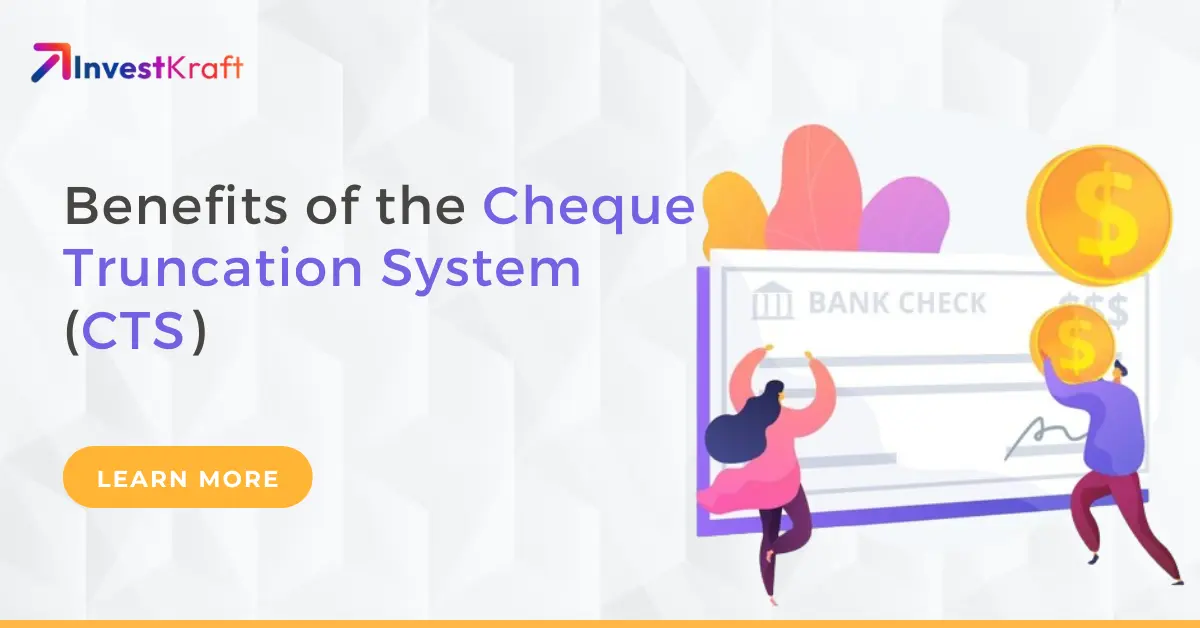How Does the Cheque Truncation System Save Time and Money?

Cheque truncation is an electronic clearing method used to settle and clear cheques between banks without physical paperwork or the cheque itself. Its purpose is to speed up the cheque-clearing process, resulting in transactions being processed within minutes. This system has greatly reduced the time taken for cheque-based transactions to be completed.
Cheque truncation, introduced in India in 2008, is a widely used system in many countries for clearing cheques quickly. This article provides detailed information on everything you need to know about cheque transactions. Keep reading to gain insights into this essential system for expediting cheque clearance.
How Do You Define the Cheque Truncation System (CTS)?
Cheque truncation is the process of electronically transmitting an image of a physical cheque to the paying branch instead of physically transporting it. Relevant information such as the MICR band data, presentation date and presenting bank is also included. This eliminates the need for the physical movement of cheques between bank branches, reducing costs and collection time. Overall, cheque truncation streamlines the entire process of cheque processing.
Why Did the RBI Introduce CTS?
Despite the availability of major services like RTGS and NEFT for online and near-real-time payments, cheques continue to be the most popular payment mode in the country. The RBI recognized this and focused on enhancing the efficiency of the cheque-clearing cycle to keep up with the changing dynamics of digital payments.
The implementation of this mechanism was aimed at expediting the clearance of cheques by halting the flow of physical cheques from the drawer to the drawee branch. This not only reduces the costs associated with the physical movement of cheques but also minimizes the time required for collection while adding efficiency to the processing procedure.
Additionally, there were quite a few inefficiencies in the traditional cheque-clearing system discussed below.
- Slow Processing Time: Cheques took a long time to process due to the physical transportation between banks. This caused delays in clearing and settlement, resulting in funds being available in the recipient’s account after several days or more.
- Expensive: The high costs associated with processing and transporting paper cheques were a significant challenge for banks. Managing these operations required substantial investment in infrastructure and personnel, adding to the overall expenses for financial institutions.
- Fraud and Forgeries: The paper-based system’s vulnerability to fraud and forgeries risked significant financial losses for banks and consumers due to the ease with which cheques could be altered or counterfeited.
- Lack of Efficiency: The inefficient clearing process, involving the physical movement of checks, resulted in a lack of transparency and efficiency. This made it difficult to track the real-time status of individual cheques.
- Environmental Impact: The production and transportation of paper cheques had significant environmental consequences, including deforestation and a considerable carbon footprint.
- Incompatibility with Modern Banking: As the world goes digital, traditional cheque-clearing methods do not align with modern banking practices. Customers crave instant access to funds, user-friendly mobile banking and seamless integration with other financial tools. However, relying on paper cheques and manual processing creates a gap between customer expectations and the cheque-clearing experience they receive
How Secured is the CTS Process?
CTS has a robust security architecture based on PKI (Public Key Infrastructure) with various authentication controls like dual access control, user ID, passwords and interfaces like smart cards and cryptobox. This ensures comprehensive security for the CTS system.
Benefits of the Cheque Truncation System (CTS)
The following pointers highlight all the major benefits of the cheque truncation system (CTS) -
- The proceeds of a cheque can be realized on the same day
- Data storage and retrieval are made easy
- Minimize risks by implementing a secure cheque-clearing system
- Significant cost savings as a result of reduced expenses in physically moving cheques
- Minimizes bottlenecks and delays between the presentation and realization stages resulting in a significant improvement in efficiency and productivity
- Offers shorter clearing cycles and a centralized image archival system
- Extended the deadline for accepting customer cheques
- The process of retrieving information is made effortless and convenient
- Timelines for faster clearance
- MICR amount encoding is not necessary
- The reconciliation difference has been eliminated as MICR and image data now travel together
- No lost or tampered cheques
- There is no risk of data and images being manipulated during transit
- Enhanced security and automation through CTS 2010 standards
What is a CTS 2010 Standard Cheque?
CTS 2010 standards are crucial for standardizing cheques issued by banks in the country. These standards specify mandatory minimum-security features on cheque forms such as void pantograph, invisible ink for the bank’s logo, watermark, paper quality etc. Additionally, CTS 2010 also focuses on standardization field placements on cheques, which assists presenting banks in scrutinizing and recognizing cheques during image-based processing. These measures ensure security and efficiency in cheque processing across banks.
Step-by-Step Cheque Truncation System Process
The cheque truncation system can be divided into two processes - the scanning & image capturing of cheques and the transmission & clearing of digital cheque images
- Outward clearing involves the electronic scanning and verification of deposited cheques at the bank branch level before they are forwarded to the service branch. This process is crucial for ensuring the efficient processing of cheques and minimizing the risk of errors or fraud
- Inward clearing is an important process carried out at the service branch to verify and balance received cheques before sending them on to a clearing house. This ensures that the cheques are properly processed and settled, contributing to the smooth operation of the banking system
The step-by-step process of the working of the cheque truncation system is given below -
- Step 1: The branch utilizes a scanner and processing software to obtain important data from the cheque, such as the information contained in its MICR band and any accompanying images
- Step 2: The branch forwards the cheque image and data to a central processing location or clearing house where it undergoes thorough processing and verification
- Step 3: The clearing house transfers the data to the paying or destination bank branch through a secure clearinghouse interface. During this stage, the payment is processed and the funds are either credited or debited from the respective bank accounts
Are There any Disadvantages of the Cheque Truncation System (CTS)?
Like every coin has 2 faces, there are both advantages and disadvantages to the cheque truncation system. In this section we will discuss the disadvantages of CTS -
- Implementing a cheque truncation system in any country involves the participation of all regional banks, which can be quite expensive. The cost of such implementation can be substantial
- Given the decreasing volume of cheque payments, banks are cautious about investing heavily in new hardware and systems due to the added complexity and the challenge of justifying such an investment compared to other payment technologies
- The complexity of the new system is increased by the addition of new hardware, software, systems and processes. This makes it more challenging to justify its cost compared to other payment technologies
- Given the potential vulnerability of electronic transmission of cheque data and images, it is crucial to implement stringent security measures to guard against fraud and breaches. Without proper safeguards in place, sensitive financial information may be at risk of compromise, making it imperative to prioritize protocols when handling such data
- The implementation of cheque truncation systems demands substantial technological infrastructure and investment, posing a potential barrier for certain financial institutions
- Transitioning to cheque truncation may necessitate significant changes in operational processes and staff training, causing potential disruption and increased costs for the organization. Implementing new procedures and providing training can be resource-intensive and may impact day-to-day operations
- Educating customers on new processes and potential changes in cheque-clearing times can be a challenge for banks
- Financial institutions must adhere to a multitude of regulations and standards related to cheque truncation, which can significantly complicate their day-to-day operations. Ensuring compliance with these requirements requires additional resources and careful attention to detail, impacting the overall efficiency of the institution.
Conclusion
In conclusion, the Cheque Truncation System (CTS) has brought a revolution in the process of cheque clearing in India. Through the electronic transmission of cheque images, CTS has effectively reduced processing time, and costs and enhanced security in comparison to traditional paper-based methods. The benefits of CTS include faster access to funds, improved efficiency and a lower risk of fraud. Despite the initial investment required for implementing CTS, the long-term advantages outweigh the costs for both banks and customers.
Frequently Asked Questions (FAQs)
Q: What is the Cheque Truncation System (CTS)?
A: The Cheque Truncation System (CTS) was introduced by the RBI in 2008 as an electronic clearing system for cheques. It replaces the physical transportation of cheques between banks with digital images and MICR data, making the cheque processing faster and more secure. This system has revolutionized cheque clearance by minimizing the need for physical handling and reducing the time required for processing.
Q: How does the CTS process work?
A: When depositing a cheque at a bank branch, the teller scans the cheque to capture a digital image and electronically captures the MICR code for account information. The digital information, including the image and MICR data, is securely sent to the drawee bank for clearing and settlement
Q: Are there any situations where a physical cheque might still be required?
A: Instances may arise where a physical cheque is required despite the growing popularity of CTS. Such situations include:
- The bank sets a limit for high-value cheques
- Damaged cheques can have unclear digital images
- Payee bank requirements
Q: How can I find out if my bank participates in CTS?
A: Verify if your bank has adopted the CTS system by checking its website or reaching out to its customer care
Q: What happens if there is a discrepancy with the cheque image or MICR data?
A: If there are discrepancies between the cheque image and MICR data, your bank will be informed by the drawee bank. You may need to provide a physical copy of the cheque for additional verification
Q: Are there any charges associated with CTS?
A: Typically, there are no additional fees for using CTS. However, your bank may still apply its regular check deposit charges
Q: How long are cheque images stored electronically under CTS?
A: The RBI has made it compulsory for banks to keep electronic copies of cheque images for a required duration, usually between 7 to 10 years. This enables banks to easily retrieve these images for future reference or in case of any disputes
Q: What are the CTS grids, and how do they impact cheque-clearing times?
A: India’s geographic division into CTS grids results in faster clearance of local grid cheques compared to those drawn on banks outside the grid due to minimal routing requirements and swifter processing
Q: Is CTS available for online cheque deposits?
A: Some banks have started to provide remote cheque deposit services through their mobile banking apps. This allows users to digitally capture images of their cheques using their smartphone cameras. The images are then processed electronically for clearing through the Cheque Truncation System (CTS)

Author: Abhik Das
Abhik Das is a versatile content writer with over 5 years of experience crafting engaging and informative content across diverse industries. His expertise spans the fields of ed-tech, pharmaceuticals, organic food, travel, sports, and finance.
Here's what sets Abhik apart:
Content Versatility: Able to adapt writing style and tone to suit various audiences and content needs.
SEO Proficiency: Creates content optimized for search engines, ensuring discoverability and organic traffic.
Deep Research: Conducts thorough research to ensure content accuracy and credibility across complex topics.
Engaging Storytelling: Captures reader interest with clear, concise, and compelling writing.
Abhik's diverse background empowers him to deliver insightful content across a wide range of subjects. Whether you're seeking engaging explainer pieces on the latest financial trends, informative guides to organic food choices, or captivating travelogues, Abhik has the expertise to craft content that resonates with your audience.





















